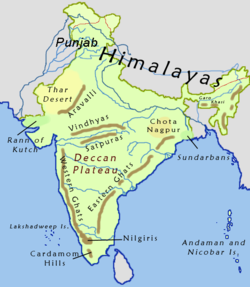Eastern Ghats
This article possibly contains original research. (December 2007) |
This article relies largely or entirely on a single source. (December 2007) |

The Eastern Ghats are a discontinuous range of mountains along India's eastern coast. The Eastern Ghats run from West Bengal state in the north, through Orissa and Andhra Pradesh to Tamil Nadu in the south. They are eroded and cut through by the four major rivers of southern India, the Godavari, Mahanadi, Krishna, and Kaveri. The mountain ranges run parallel to the Bay of Bengal. The Deccan Plateau lies to the west of the range, between the Eastern Ghats and Western Ghats. The coastal plains lies between the Eastern Ghats and the Bay of Bengal. The Eastern Ghats are not as high as the Western Ghats. As with the Western Ghats, these mountain ranges also have their local names, e.g. the Velikonda Range of Andhra Pradesh.
At their southern end, the Eastern Ghats form several ranges of low hills. The southernmost of the Eastern Ghats are the low Sirumalai and Karanthamalai Hills of southern Tamil Nadu. North of the River Kaveri are higher Kollimalai, Pachaimalai, Shevaroy (Servaroyan), Kalrayan Hills, Chitteri, Palamalai and Mettur Hills in northern Tamil Nadu state. The climate of the higher hill ranges is generally cooler and wetter than the surrounding plains and the hills are home to coffee plantations and enclaves of dry forest. The hill station of Yercaud is located in the Shevaroy Hills. The Bilgiri Hills, which run east from the Western Ghats to the River Kaveri, forms a forested ecological corridor that connects the Eastern and Western Ghats, and allows the second-largest wild elephant population in India to range between the South Eastern Ghats, the Biligiri and Nilgiri Hills, and the South Western Ghats.
The Ponnaiyar and Palar Rivers flow from headwaters on the Kolar Plateau eastward through gaps in the Ghats to empty into the Bay of Bengal; the Javadhu Hills lie between the two rivers. There are waterfalls in remote areas, such as the Kiliyur Falls.[1]
North of the Palar River in Andhra Pradesh, the central portion of the Eastern Ghats consist of two parallel ranges running approximately north-south; the lower Velikonda Range lies to the east, and the higher Palikonda-Lankamalla-Nallamalla Ranges lie to the west. The Palar River cuts through the ranges. The Velikonda Range eventually descends to the coastal plain in northern Nellore district, while the Nallamalla Range continues to the Krishna River. A range of low hills lie between the Krishna and the Godavari, but north of the Godavari the Eastern Ghats increase again in height, forming the boundary between Andhra Pradesh and Orissa.
The region boasts of fertile soil but hydropower generation here is not as profitable as it is in the Western Ghats.
The Eastern Ghats are older than the Western Ghats, and have a complex geologic history, related to the assembly and breakup of the ancient supercontinent of Rodinia and the assembly of the Gondwana supercontinent.
References
- ^ "Jungle Look". The Hindu. Retrieved 2006-12-09.






